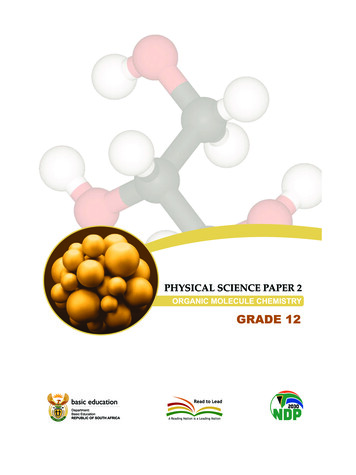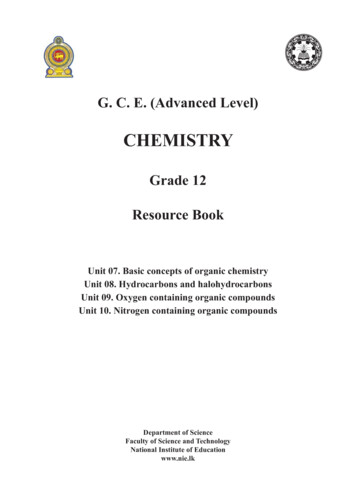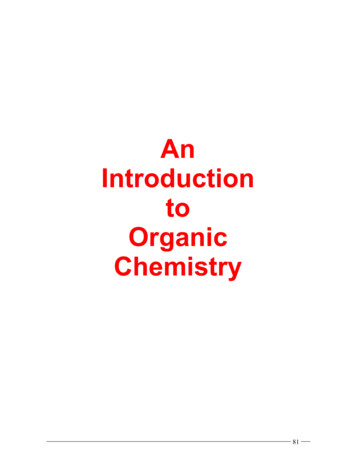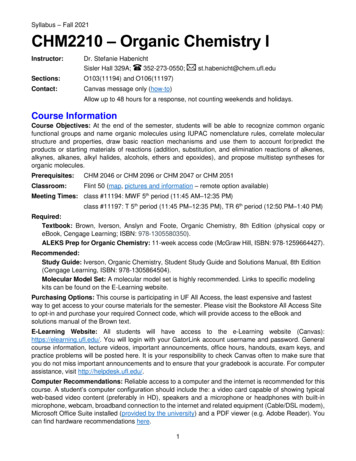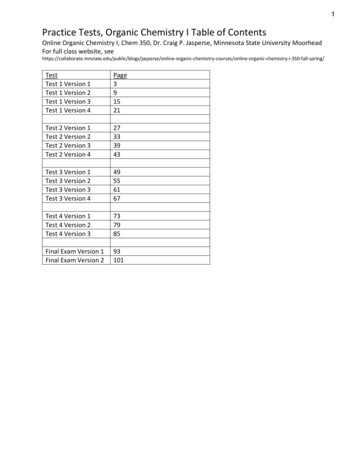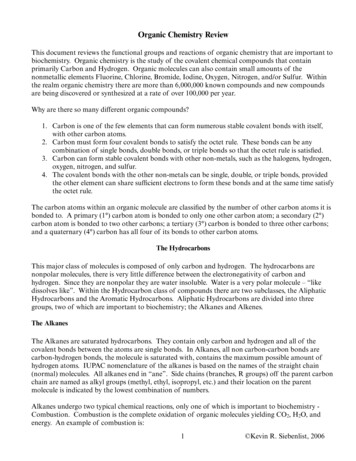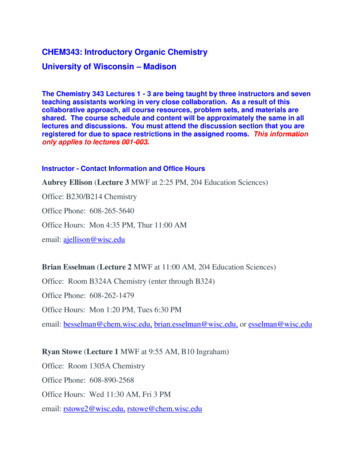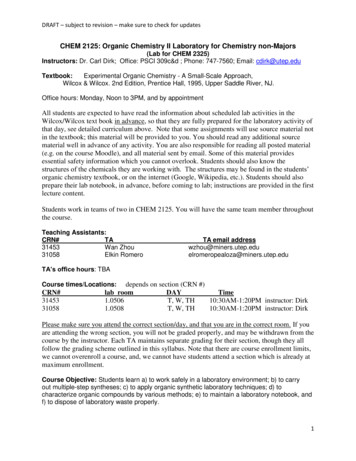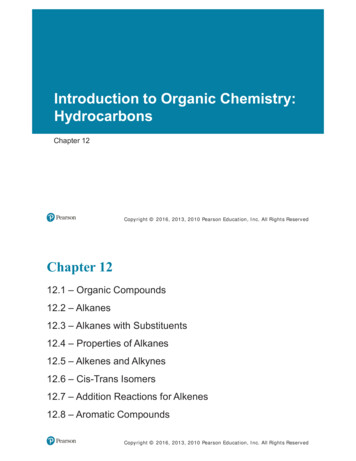
Transcription
Introduction to Organic Chemistry:HydrocarbonsChapter 12Copyright 2016, 2013, 2010 Pearson Education, Inc. All Rights ReservedChapter 1212.1 – Organic Compounds12.2 – Alkanes12.3 – Alkanes with Substituents12.4 – Properties of Alkanes12.5 – Alkenes and Alkynes12.6 – Cis-Trans Isomers12.7 – Addition Reactions for Alkenes12.8 – Aromatic CompoundsCopyright 2016, 2013, 2010 Pearson Education, Inc. All Rights Reserved
12.1 – Organic CompoundsIdentify properties characteristic of organic or inorganiccompounds.Organic CompoundsOrganic chemistry is the study of carbon compounds.An organic compound Always contains carbon and hydrogen atomsMay also contain other nonmetals such as oxygen, nitrogen,phosphorus, or a halogen.Organic compounds are found in: Gasoline, medicines, shampoos, plastics, and perfumes Carbohydrates, fats, and proteins
Functional Groups Organic compounds are organized by their functional groups (groups ofatoms bonded in a specific way).Compounds that contain the same functional groups have similarphysical and chemical properties.The identification of functional groups allows us to classify organiccompounds according to their structure, to name compounds withineach family, and to predict their chemical reactions.Organic vs. Inorganic In chemistry, molecules are classified as Organic orInorganic.Inorganic compounds are (quite expansively)anything that is not organic.Organic and Inorganic compounds have differentproperties.– Organic compounds: Have low melting and boiling points. Are flammable and undergo combustion. Are not soluble in water.– Inorganic compounds Many inorganic compounds have highmelting and boiling points. Inorganic compounds that are ionic areusually soluble in water, and most do notburn in air.Copyright 2016, 2013, 2010 Pearson Education, Inc. All Rights Reserved
Copyright 2016, 2013, 2010 Pearson Education, Inc. All Rights ReservedPracticeIdentify each characteristic as most typical of compoundsthat are inorganic or organic.A. It has a high melting point.B. It is not soluble in water.C. It contains carbon and hydrogen atoms.D. It has the formula MgCl2.E. It burns easily in air.Copyright 2016, 2013, 2010 Pearson Education, Inc. All Rights Reserved
Representations of Carbon Compounds Hydrocarbons are organic compounds that consist of only carbon andhydrogen.– In organic molecules, every carbon atom has four bonds.– In methane (CH4), the carbon atom forms an octet by sharing its fourvalence electrons with four hydrogen atoms.Three-dimensional and two-dimensional representations of methane: a)space-filling model, b) ball-and-stick model, c) wedge-dash model, d)expanded structural formula, and e) condensed structural formulaCopyright 2016, 2013, 2010 Pearson Education, Inc. All Rights ReservedRepresentations of Carbon Compounds In ethane (C2H6), each tetrahedral carbon forms three covalent bonds tohydrogen and one to the other carbon.Copyright 2016, 2013, 2010 Pearson Education, Inc. All Rights Reserved
AlkanesAlkanes are formed by a continuous chain of carbon atoms. are named using the IUPAC (International Union of Pureand Applied Chemistry) system. have names that end in ane. use Greek prefixes to name carbon chains with five ormore carbon atoms.Copyright 2016, 2013, 2010 Pearson Education, Inc. All Rights ReservedStudy CheckIn the butane molecule (C4H10), predict the shape aroundeach carbon atom.HHHHHCCCCHHHHHCopyright 2016, 2013, 2010 Pearson Education, Inc. All Rights Reserved
Chapter 1212.1 – Organic Compounds12.2 – Alkanes12.3 – Alkanes with Substituents12.4 – Properties of Alkanes12.5 – Alkenes and Alkynes12.6 – Cis-Trans Isomers12.7 – Addition Reactions for Alkenes12.8 – Aromatic CompoundsCopyright 2016, 2013, 2010 Pearson Education, Inc. All Rights Reserved12.2 - AlkanesWrite the IUPAC names and draw the condensed or line-angle structuralformulas for alkanes and cycloalkanes.Copyright 2016, 2013, 2010 Pearson Education, Inc. All Rights Reserved
Alkanes More than 90% of the compounds inthe world are organic compounds.The larger number of carboncompounds is possible because thecovalent bonds between carbonatoms (C-C) is very strong, allowingcarbon atoms to form long, stablechains.Copyright 2016, 2013, 2010 Pearson Education, Inc. All Rights ReservedAlkanes The alkanes are a type of hydrocarbon in which the carbon atoms areconnected only by single bonds.– Alkanes are formed by a continuous chain of carbon atoms.– The names of alkanes and in –ane. Such names are part of the IUPAC system (International Unionof Pure and Applied Chemistry) used by chemists to nameorganic chemistry.– Alkanes made of carbon chains are named based on how manycarbons make up the chain.– One of the most common uses of alkanes is as fuels. Methane, propane, octane, and hexane are all alkanes usedas fuels.Copyright 2016, 2013, 2010 Pearson Education, Inc. All Rights Reserved
IUPAC Names of AlkanesCopyright 2016, 2013, 2010 Pearson Education, Inc. All Rights ReservedLine-Angle Structural FormulasA simplified structure of organic molecules is called the line-angle structural formula. shows a zigzag line in which carbon atoms arerepresented as the ends of each line and as corners.Carbon atoms at the end are bonded to three hydrogen atoms. in the middle are bonded to two hydrogen atoms.Copyright 2016, 2013, 2010 Pearson Education, Inc. All Rights Reserved
Condensed formula and Line-angle formula PentaneCopyright 2016, 2013, 2010 Pearson Education, Inc. All Rights ReservedCondensed formula and Line-angle formula Draw the condensed structural formula and name the molecule:Copyright 2016, 2013, 2010 Pearson Education, Inc. All Rights Reserved
Guide to Drawing Structural Formulas forAlkanesStep 1: Draw the carbon chain.Step 2: Draw the expanded structural formula by adding thehydrogen atoms using single bonds to each of thecarbon atoms.Step 3: Draw the condensed structural formula by combiningthe H atoms with each C atom.Step 4: Draw the line-angle structural formula as a zigzagline in which the ends and corners represent Catoms.Copyright 2016, 2013, 2010 Pearson Education, Inc. All Rights ReservedDrawing Expanded, Condensed, and LineAngle Structural Formulas (1 of 3)Draw the expanded, condensed, and line-angle structuralformula for pentane.Step 1: Draw the carbon chain. A molecule of pentane hasfive carbon atoms in a continuous chain.Step 2: Draw the expanded structural formula by addingthe hydrogen atoms, using single bonds to eachof the carbon atoms.Copyright 2016, 2013, 2010 Pearson Education, Inc. All Rights Reserved
Drawing Expanded, Condensed, and LineAngle Structural Formulas (2 of 3)Draw the expanded, condensed, and line-angle structuralformula for pentane.Step 3: Draw the condensed structural formula bycombining the H atoms with each C atom.Copyright 2016, 2013, 2010 Pearson Education, Inc. All Rights ReservedDrawing Expanded, Condensed, and LineAngle Structural Formulas (3 of 3)Draw the expanded, condensed, and line-angle structuralformula for pentane.Step 4: Draw the line-angle structural formula as azigzag line in which the ends and cornersrepresent C atoms.Copyright 2016, 2013, 2010 Pearson Education, Inc. All Rights Reserved
Conformations of Alkanes Single bonds can spin and rotate.Thus different arrangements, known as conformations, occur duringthe rotation about a single tmlCopyright 2016, 2013, 2010 Pearson Education, Inc. All Rights ReservedStructural Formulas: C4H10As butane (C4H10) rotates, sometimes theline up in front of each other, and at other times they areopposite each other. Butane can be drawn using a variety oftwo-dimensional condensed structural formulas:Copyright 2016, 2013, 2010 Pearson Education, Inc. All Rights Reserved
Structural Formulas: C4H10Copyright 2016, 2013, 2010 Pearson Education, Inc. All Rights ReservedCycloalkanesHydrocarbons can also form into circles or rings called:cycloalkanes have two fewer hydrogen atoms than the open chain form. are named by using the prefix cyclo before the name ofthe alkane chain with the same number of carbon atoms.Copyright 2016, 2013, 2010 Pearson Education, Inc. All Rights Reserved
Formulas of CycloalkanesTable 12.4 Formulas of Some Common nd-Stick ModelThree carbons single-bonded to each other in a triangular pattern,with each carbon single-bonded to 2 hydrogens.The condensed structural formula shows a triangular ring of three CH 2 molecules.CyclopentaneThe line-angle structural formula is a triangle.CyclohexaneBLANKBLANKBLANKThe ball and stick model shows fivecarbons single-bonded to each other ina pentagonal pattern, with each carbonsingle-bonded to 2 hydrogens.The ball and stick model shows sixcarbons single-bonded to each other ina hexagonal pattern, with each carbon.BLANKThe condensed structural formula showsa square ring of four C H 2 molecules.BLANKThe condensed structural formulashows a pentagonal ring of five C H 2moleculesLine-Angle Structural FormulaBLANKThe ball and stick model shows fourcarbons single-bonded to each other in asquare pattern, with each carbon singlebonded to 2 hydrogensCondensed Structural FormulaBLANK.single-bonded to 2 hydrogens.BLANKThe condensed structural formulashows a hexagonal ring of six C H 2molecules.BLANKBLANKBLANKThe line-angle structural formula shows asquare.The line-angle structural formula showsThe line-angle structural formula showsa hexagon.a pentagonCopyright 2016, 2013, 2010 Pearson Education, Inc. All Rights ReservedStudy CheckGive the IUPAC name for each of the following compounds:A.B.Copyright 2016, 2013, 2010 Pearson Education, Inc. All Rights Reserved
Study CheckName the following alkanes:A.B.C.D.Copyright 2016, 2013, 2010 Pearson Education, Inc. All Rights ReservedChapter 1212.1 – Organic Compounds12.2 – Alkanes12.3 – Alkanes with Substituents12.4 – Properties of Alkanes12.5 – Alkenes and Alkynes12.6 – Cis-Trans Isomers12.7 – Addition Reactions for Alkenes12.8 – Aromatic CompoundsCopyright 2016, 2013, 2010 Pearson Education, Inc. All Rights Reserved
12.3 – Alkanes and SubstituentsWrite the IUPAC names for alkanes with substituents and draw theircondensed and line-angle structural formulas.Copyright 2016, 2013, 2010 Pearson Education, Inc. All Rights ReservedStructural IsomersStructural isomers have the same molecular formula with a different arrangementof atoms. have the same number of atoms bonded in a different order.Butane (C4H10) has two structural isomers: a straight chain and abranched chain.Copyright 2016, 2013, 2010 Pearson Education, Inc. All Rights Reserved
Study CheckDraw three possible structural isomers of pentane(C5H12).Copyright 2016, 2013, 2010 Pearson Education, Inc. All Rights ReservedSolutionDraw three possible structural isomers of pentane(C5H12).StructuralIsomers ofC5H12Structural Isomers of C5H12Structural Isomers ofC5H12Structural Isomersof C5H12CondensedThe first condensed structural formula is a straight chain of single-bonded molecules as follows. C H 3, C H 2, C H 2, C H 2, C H 3.The second condensed structural formula is a branched chain as follows. C H 3, C H single-bonded to C H 3 above,C H 2, C H 3.The third condensed structural formula is a central Csingle-bonded to four C H 3 molecules above, below,rightward, and leftward.Line-AngleThe line-angle structural formula shows a zigzag line made of 4 segments forming 3 angles.The line-angle structural formula shows a zigzag of 3 segments forming 2 angles, witha fourth segment rising vertically from the first angle.The line-angle structural formula shows 2 rising and falling linesegments with 2 segments rising diagonally right and left from the angle.Copyright 2016, 2013, 2010 Pearson Education, Inc. All Rights Reserved
Study CheckIs the pair of formulas structural isomers? Or the same molecule?Copyright 2016, 2013, 2010 Pearson Education, Inc. All Rights ReservedSubstituents in Alkanes When CH3 branches off of a carbon chain, it’s called an alkyl group When a halogen atom (Group 17) is attached to a carbon chain, it isnamed as a halo group with the terms –fluoro, -chloro, -bromo, -iodobased on which element it is.Copyright 2016, 2013, 2010 Pearson Education, Inc. All Rights Reserved
Substituents and Alkyl GroupsTable 12.5 Formulas and Names of Some Common SubstituentsFormulaNameFormula, C H 3, single bond. name, methyl.FormulaNameFormula, straight chain, C H 3, C H 2, C H 2, single bond. name,propyl.FormulaNameFormula, straight chain, C H 3, C H 2, C H 2, C H 2, single bond.name, butyl.FormulaNameFormula, F, single bond. name, fluoro.singlebond. name, ethyl.BLANKBLANKFormula, branched chain, C H 3, C H with single bond above, CBLANKBLANKFormula, branched chain, C H 3, C H single-bonded to C H 3above, C H 2, single bond. name, isobutyl.Formula, C H 3, C H with single bond above, C H 2,C H 3. name, secondary butyl.Formula, central C with single bondabove and three C H 3 moleculesbelow, rightward, and leftward.name, tertiary butyl.Formula, F, single bond. name, fluoro.Formula, B r, single bond. name, bromo.Formula, I, single bond. name, iodo.Formula, straight chain, C H 3, C H 2,H 3. name, isopropyl.Copyright 2016, 2013, 2010 Pearson Education, Inc. All Rights ReservedNaming Alkanes with SubstituentsCopyright 2016, 2013, 2010 Pearson Education, Inc. All Rights Reserved
Naming Alkanes with SubstituentsCopyright 2016, 2013, 2010 Pearson Education, Inc. All Rights ReservedNaming Cycloalkanes with SubstituentsCopyright 2016, 2013, 2010 Pearson Education, Inc. All Rights Reserved
Naming Cycloalkanes with SubstituentsCopyright 2016, 2013, 2010 Pearson Education, Inc. All Rights ReservedNaming HaloalkanesHaloalkanes are alakanes with a halogen atom that replaces a hydrogen atom. are named by putting the substituents in alphabetical order. have the halo group numbered according to the carbon where it isattached to the alkane.Examples ofHaloalkanesBLANKBLANKBLANKBLANKFormulastraight chain, C H 3, C lstraight chain, C H 3, C H 2, B rBranched chain, C H 3, C H single-bonded to an F aboveA central C single-bonded to C l above and three C H 3 molecules below, rightward, and ne2-Chloro-2methylpropaneCommonMethyl chlorideEthyl bromideIsopropyl fluorideTert-Butyl chlorideCopyright 2016, 2013, 2010 Pearson Education, Inc. All Rights Reserved
Drawing the molecule from the nameDraw the condensed and line-angle structural formulas for2,3-dimethylbutane.Copyright 2016, 2013, 2010 Pearson Education, Inc. All Rights ReservedDrawing the molecule from the nameDraw the condensed and line-angle structural formulas for2-bromo-3-ethyl-4-methylpentane.Copyright 2016, 2013, 2010 Pearson Education, Inc. All Rights Reserved
Chapter 1212.1 – Organic Compounds12.2 – Alkanes12.3 – Alkanes with Substituents12.4 – Properties of Alkanes12.5 – Alkenes and Alkynes12.6 – Cis-Trans Isomers12.7 – Addition Reactions for Alkenes12.8 – Aromatic CompoundsCopyright 2016, 2013, 2010 Pearson Education, Inc. All Rights Reserved12.4 – Properties of AlkanesIdentify the properties of alkanes and write a balanced chemicalequation for combustion.Copyright 2016, 2013, 2010 Pearson Education, Inc. All Rights Reserved
Properties of AlkanesMany types of alkanes are the componentsof fuels that power our cars and oil thatheats our home.The solid alkanes that make up waxycoatings on fruits and vegetables helpretain moisture, inhibit mold, and enhanceappearance.The different uses of alkane compoundsresult from their physical properties,including their solubility and density.Copyright 2016, 2013, 2010 Pearson Education, Inc. All Rights ReservedUses of Alkanes (1 of 2)Alkanes with one to four carbons are gases at roomtemperature and are widely used as heating fuels.methane, ethane, propane, butaneButane has four carbons:Alkanes with five to eight carbons are highly volatile liquidsat room temperature, which makes them useful as fuels.pentane, hexane, heptane, octaneOctane has eight carbons:Copyright 2016, 2013, 2010 Pearson Education, Inc. All Rights Reserved
Uses of Alkanes (2 of 2)Alkanes with 9 17 carbons are liquids with higher boilingpoints and are found in motor oils, mineral oil, kerosene,diesel, and jet fuels.Decane has 10 carbons: Alkanes with 18 or more carbon atoms, known asparaffins, are waxy solids at room temperature. Petroleum jelly, or Vaseline, is a semisolid mixture ofhydrocarbons with more than 25 carbon atoms.Copyright 2016, 2013, 2010 Pearson Education, Inc. All Rights ReservedMelting and Boiling Points (1 of 4)Alkanes have the lowest melting and boiling points of organiccompounds. contain only the nonpolar bonds of exhibit only weak dispersion forces in the solid and liquid states.Longer-chain alkanes have more dispersion forces.Copyright 2016, 2013, 2010 Pearson Education, Inc. All Rights Reserved
Melting and Boiling Points (2 of 4)Branched alkanes have lower boiling points than the straight-chain isomers.Copyright 2016, 2013, 2010 Pearson Education, Inc. All Rights ReservedMelting and Boiling Points (2 of 4)Branched alkanes have lower boiling points than the straight-chain isomers. tend to be more compact, reducing the points of contactbetween the molecules. do not have linear shapes and cannot line up close to eachother.Copyright 2016, 2013, 2010 Pearson Education, Inc. All Rights Reserved
Melting and Boiling Points (3 of 4)Cycloalkanes have higher boiling points than the straight-chain alkaneswith the same number of carbon atoms. have limited rotation of carbon bonds; they maintain theirrigid structure and can be stacked closely together, whichgives them many points of contact and attractions to eachother.Copyright 2016, 2013, 2010 Pearson Education, Inc. All Rights ReservedMelting and Boiling Points (4 of 4)We can compare the boiling points of straight-chain alkanes,branched-chain alkanes, and cycloalkanes.Table 12.6 Comparison of Boiling Points of Alkanes and Cycloalkanes with Five CarbonsFormulaStraight-Chain AlkaneStraight chain alkanes. condensed structural formula, C H 3, C H 2, C H 2, C H 2, C H 3Branched-Chain AlkanesBranched chain alkanes. condensed structural formula, C H 3, C H single-bonded to C H 3, C H 2, C H 3Central C single-bonded to four C H 3 moleculesCycloalkaneline-angle structural formula, a pentagonal ringNameBoiling Point ( ethylpropane10BLANKBLANKCyclopentane49Copyright 2016, 2013, 2010 Pearson Education, Inc. All Rights Reserved
Combustion of Alkanes (1 of 3)The carbon–carbon single bonds in alkanes are difficult tobreak, which makes them the least reactive family of organiccompounds.However, alkanes burn readily in oxygen to produce carbondioxide, water, and energy.Alkane g O2 g ' CO2 g H2O g energyCopyright 2016, 2013, 2010 Pearson Education, Inc. All Rights ReservedCombustion of Alkanes (3 of 3)Methane is the natural gas we use to cook our food andheat our homes. The equation for the combustion ofmethane (CH4) is written as follows:CH4 g 2O2 g ' CO2 g 2H2O g energyPropane is the gas used in portable heaters and gasbarbecues. The equation for the combustion of propane(C3H8) is written as follows:CH4 g 5O2 g ' 3CO2 g 4H2O g energyCopyright 2016, 2013, 2010 Pearson Education, Inc. All Rights Reserved
Solubility and Density of AlkanesAlkanes are nonpolar. insoluble in water. less dense than water. flammable in air. found in crude oil.If there is an oil spill in the ocean, the alkanes in the crude oildo not mix with the water but float on top, forming a thinlayer on the surface.Copyright 2016, 2013, 2010 Pearson Education, Inc. All Rights ReservedChapter 1212.1 – Organic Compounds12.2 – Alkanes12.3 – Alkanes with Substituents12.4 – Properties of Alkanes12.5 – Alkenes and Alkynes12.6 – Cis-Trans Isomers12.7 – Addition Reactions for Alkenes12.8 – Aromatic CompoundsCopyright 2016, 2013, 2010 Pearson Education, Inc. All Rights Reserved
12.5 – Alkenes and AlkynesIdentify structural formulas as alkenes, cycloalkenes, and alkynes and write theirIUPAC names.Copyright 2016, 2013, 2010 Pearson Education, Inc. All Rights ReservedAlkenes and AlkynesAlkenes are hydrocarbons that contain double bonds.Alkynes are hydrocarbons that contain triple bonds are called unsaturated hydrocarbons because they do notcontain the maximum number of hydrogen atoms. react with hydrogen gas to increase the number ofhydrogen atoms and become alkanes.Remember, carbon atoms always form four covalent bonds.Copyright 2016, 2013, 2010 Pearson Education, Inc. All Rights Reserved
Identifying AlkenesAlkenes contain one or more carbon–carbon doublebonds.In ethene (C2H4), two carbon atoms are connected by adouble bond.Each carbon atom in the double bond is attached to twohydrogen atoms and has a trigonal planar arrangementwith bond angles of 120 .Copyright 2016, 2013, 2010 Pearson Education, Inc. All Rights ReservedEthene (C2H4)Ethene (C2H4), more commonlycalled ethylene, is an important plant hormoneinvolved in promoting theripening of fruits such asbananas. accelerates the breakdown ofcellulose in plants, whichcauses flowers to wilt andleaves to fall from trees.Copyright 2016, 2013, 2010 Pearson Education, Inc. All Rights Reserved
Other alkene examplesCopyright 2016, 2013, 2010 Pearson Education, Inc. All Rights ReservedIdentifying AlkynesAlkynes contain one or more carbon–carbon triple bonds.In ethyne (C2H2), each carbon is also bonded to one H atom.Each carbon atom in the triple bond has a lineararrangement with bond angles of 180 .Copyright 2016, 2013, 2010 Pearson Education, Inc. All Rights Reserved
Ethyne (C2H2)Ethyne (C2H2), more commonlycalled acetylene Is used in welding where itreacts with oxygen to produceflames with temperaturesabove 3300 CCopyright 2016, 2013, 2010 Pearson Education, Inc. All Rights ReservedOther alkyne examplesCopyright 2016, 2013, 2010 Pearson Education, Inc. All Rights Reserved
Study Check (1 of 4)Identify each of the following compounds as an alkeneor alkyne:A.B.Copyright 2016, 2013, 2010 Pearson Education, Inc. All Rights ReservedNaming Alkanes, Alkenes, and AlkynesThe IUPAC names for alkenes and alkynes are similar to those of alkanes. use the alkane name with the same number of carbonatoms, replacing the ane ending with ene.Cyclic alkenes are named as cycloalkenes.Table 12.7 Comparison of Names for Alkanes, Alkenes, and AlkynesCopyright 2016, 2013, 2010 Pearson Education, Inc. All Rights Reserved
Study CheckWrite IUPAC name for the following:Copyright 2016, 2013, 2010 Pearson Education, Inc. All Rights ReservedStudy CheckWrite IUPAC name for the following:Copyright 2016, 2013, 2010 Pearson Education, Inc. All Rights Reserved
Solution (1 of 4)Step 1: Name the longest carbon chain that contains the double ortriple bond.Analyze the ProblemAnalyze the ProblemGivenfive-carbon chain double bond,methyl groupGivensix-carbon triple bondNeedNeedIUPAC nameIUPAC namefive carbon atoms—pentenesix carbon atoms—hexyneA.B.Copyright 2016, 2013, 2010 Pearson Education, Inc. All Rights ReservedSolution (2 of 4)Step 2: Number the carbon chain, starting from theend nearer the double or triple bond.1A.32542-pentene5B.463212-hexyneCopyright 2016, 2013, 2010 Pearson Education, Inc. All Rights Reserved
Solution (3 of 4)Step 3: Give the location and name of eachsubstituent (alphabetical order) as a prefixto the alkeneor alkyne name.1A.32544-methyl-2-pentene5B.463212-hexyne; there are nosubstituents in this compound.Copyright 2016, 2013, 2010 Pearson Education, Inc. All Rights ReservedNaming CycloalkenesCycloalkenes have a double bond within a ring structure and are named by assigning the double bond to be between carbon1 and carbon 2 when a substituent is on the ring. do not need to include the numbers for the double bond.3-methylcyclopentene (It is understood that thedouble bond is between carbon 1 and carbon 2.)The carbon atoms in the ring are numbered to give the doublebond numbers 1 and 2 and the lowest possible number to anysubstituents present.Copyright 2016, 2013, 2010 Pearson Education, Inc. All Rights Reserved
Study Check (4 of 4)Name the following alkenes and alkynes:Copyright 2016, 2013, 2010 Pearson Education, Inc. All Rights ReservedSolution (4 of 4)Name the following alkenes and ht 2016, 2013, 2010 Pearson Education, Inc. All Rights Reserved
Chemistry Link to the Environment:Fragrant Alkenes (1 of 2)The odors you associate withlemons, oranges, roses, andlavender come from thevolatile compounds that aresynthesized by the plantsthat produce these flowersand fruits.Often these compoundscontain double or triple bondsor ring structures; they areunsaturated.Copyright 2016, 2013, 2010 Pearson Education, Inc. All Rights ReservedChapter 1212.1 – Organic Compounds12.2 – Alkanes12.3 – Alkanes with Substituents12.4 – Properties of Alkanes12.5 – Alkenes and Alkynes12.6 – Cis-Trans Isomers12.7 – Addition Reactions for Alkenes12.8 – Aromatic CompoundsCopyright 2016, 2013, 2010 Pearson Education, Inc. All Rights Reserved
Cis–Trans IsomersIn an alkene, the double bond is rigid and does not rotate.Copyright 2016, 2013, 2010 Pearson Education, Inc. All Rights ReservedCis–Trans Isomers (1 of 2)In an alkene, the double bond is rigid and does not rotate. holds attached groups in fixed positions. makes cis–trans isomers (geometric isomers) possible when twodifferent groups are attached to the carbon atoms on each side of thedouble bond. requires a prefix of cis or trans to reflect the arrangement of groupsacross the double bond.Copyright 2016, 2013, 2010 Pearson Education, Inc. All Rights Reserved
Cis–Trans IsomersCis–trans isomers have different physical and chemical properties.Copyright 2016, 2013, 2010 Pearson Education, Inc. All Rights ReservedCis–Trans Isomers of Butene In a cis isomer, the alkyl groups are attached on the same side of thedouble bond and H atoms are on the other side. In the trans isomer, the groups and H atoms are attached on oppositesides of the double bond.Copyright 2016, 2013, 2010 Pearson Education, Inc. All Rights Reserved
Cis–Trans Isomers (2 of 2)Cis–trans isomers cannot occur when two groups are the same on one of thecarbons.Copyright 2016, 2013, 2010 Pearson Education, Inc. All Rights ReservedChemistry Link to the Environment:Pheromones (1 of 2)Many insects emit minute quantities of chemicals calledpheromones to send others of the same speciesmessages.Pheromones may warn an insect ofdanger. mark a trail. attract the opposite sex.Copyright 2016, 2013, 2010 Pearson Education, Inc. All Rights Reserved
Chemistry Link to the Environment:Pheromones (2 of 2)The effectiveness of many of these pheromones depends on thecis or trans configuration of the double bonds in the molecules.One pheromone is bombykol, the sex pheromone produced by the female silkworm moth. which contains one cis double bond and one trans double bond.Copyright 2016, 2013, 2010 Pearson Education, Inc. All Rights ReservedCis–Trans IsomersIdentify each of the following as cis or transCopyright 2016, 2013, 2010 Pearson Education, Inc. All Rights Reserved
Naming Cis–Trans IsomersThe prefix of cis or trans is placed in front of the alkenename when the compound is a cis or trans isomer.Copyright 2016, 2013, 2010 Pearson Education, Inc. All Rights ReservedStudy CheckName, using cis or trans prefixes when needed.Copyright 2016, 2013, 2010 Pearson Education, Inc. All Rights Reserved
Study CheckName, using cis or trans prefixes when needed.Copyright 2016, 2013, 2010 Pearson Education, Inc. All Rights ReservedStudy CheckName, using cis or trans prefixes when needed.Copyright 2016, 2013, 2010 Pearson Education, Inc. All Rights Reserved
SolutionName each, using cis or trans prefixes when buteneC.trans-2-buteneCopyright 2016, 2013, 2010 Pearson Education, Inc. All Rights ReservedChapter 1212.1 – Organic Compounds12.2 – Alkanes12.3 – Alkanes with Substituents12.4 – Properties of Alkanes12.5 – Alkenes and Alkynes12.6 – Cis-Trans Isomers12.7 – Addition Reactions for Alkenes12.8 – Aromatic CompoundsCopyright 2016, 2013, 2010 Pearson Education, Inc. All Rights Reserved
12.7 – Addition Reactions for AlkenesDraw the condensed or line-angle structural formulas and give the names ofthe organic products of addition reactions of alkenes. Draw a condensedstructural formula for a section of a polymer.Copyright 2016, 2013, 2010 Pearson Education, Inc. All Rights ReservedAddition Reactions Alkanes are very stable and nonreactive.Alkenes and Alkynes, on the other hand, react readily with othermolecules due to the double and triple bonds.– These bonds act as an “electron source.” (Two electrons per bond.)– Addition reactions are the most common, where something isadded to each carbon in the double or triple bond. We will focus on alkenes, however these reactions can apply to alkynesas well.Copyright 2016, 2013, 2010 Pearson Education, Inc. All Rights Reserved
Hydrogenation In hydrogenation, H atoms add to each of the carbon atoms in adouble bond of an alkene.During hydrogenation, the double bonds are converted to single bondsof alkanes.A catalyst, such as platinum (Pt), nickel (Ni), or palladium (Pd) is used tospeed up the reaction.Copyright 2016, 2013, 2010 Pearson Education, Inc. All Rights ReservedPracticeCopyright 2016, 2013, 2010 Pearson Education, Inc. All Rights Reserved
Hydration In hydration, an alkene reactions with water (H-OH). A hydrogen atom (H-)from water forms a bond with one carbon a
12.1 -Organic Compounds Identify properties characteristic of organic or inorganic compounds. Organic Compounds Organic chemistryis the study of carbon compounds. An organic compound Always contains carbon and hydrogen atoms May also contain other nonmetals such as oxygen, nitrogen, phosphorus, or a halogen. Organic compounds are .

